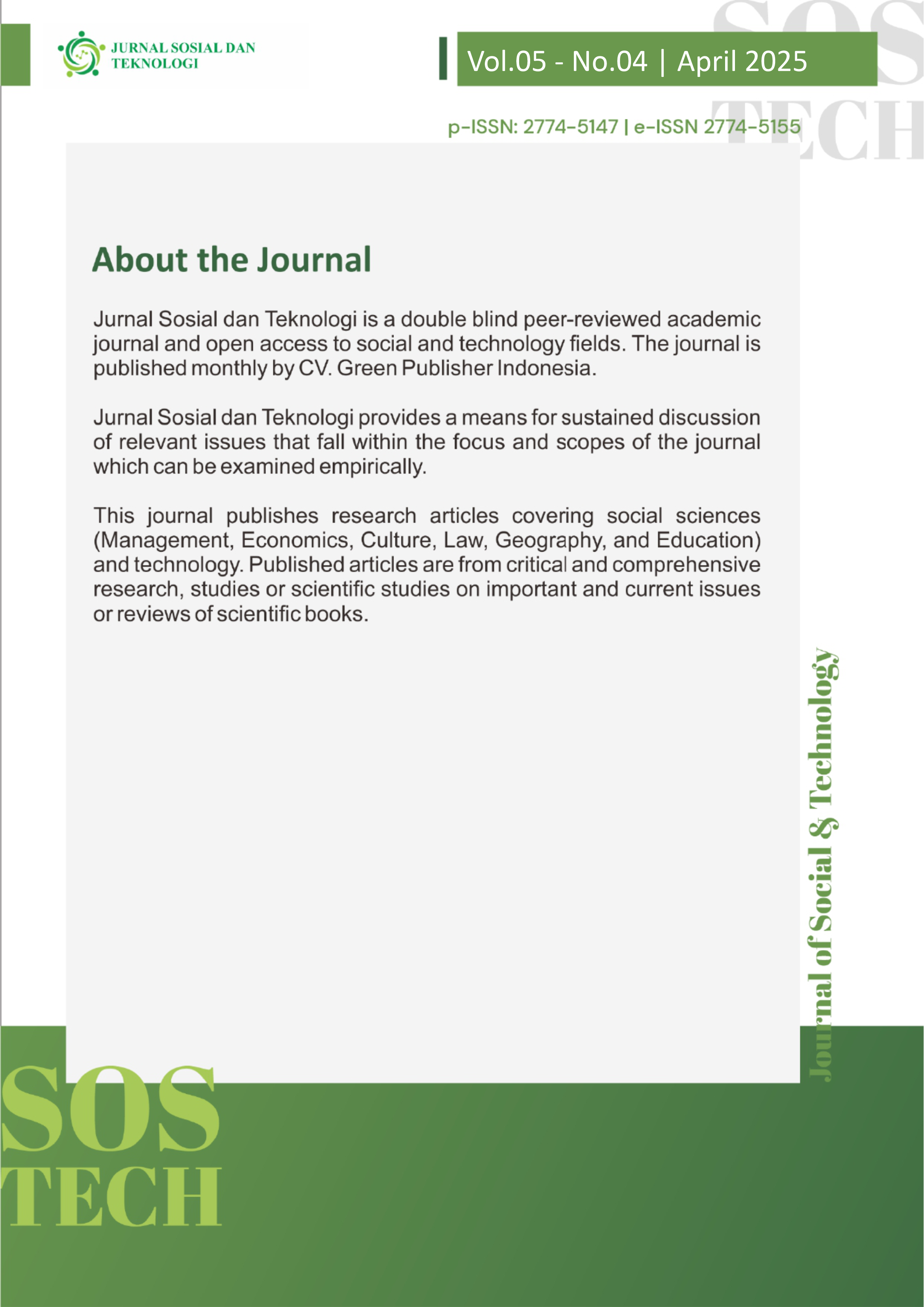Legal Policy in the Legal System: Concept, Implementation, and Challenges
DOI:
https://doi.org/10.59188/jurnalsostech.v5i4.32080Keywords:
human resources management, web-based application, system development life cycle, waterfall model, employee data managementAbstract
This study aims to design and develop a web-based Human Resources Management (HRM) application to simplify the human resource management process at PT. Perkasa Satria Nusantara. The application development follows the Waterfall model of the System Development Life Cycle (SDLC), which includes planning, analysis, design, implementation, and testing stages. The research uses interviews with a Likert scale to collect data regarding user needs and the HR process in the company. The results show that the developed application improves the efficiency of managing employee data, attendance, and related reports in a more structured and organized manner. This application also facilitates the HR department at PT. Perkasa Satria Nusantara in managing employee data more effectively, reducing manual errors, and speeding up administrative processes. The implications of this research suggest that the web-based HRM application can reduce manual errors, expedite HR administrative management, and support faster and more accurate decision-making. This application is expected to improve the operational efficiency of the company in managing human resources. In the future, this application can be further developed by adding additional features such as recruitment and training management to support the development of human resources in the company.
References
Agustian, K., Pohan, A., Zen, A., Wiwin, W., & Malik, A. J. (2023). Human resource management strategies in achieving competitive advantage in business administration. Journal of Contemporary Administration and Management (ADMAN), 1(2), 108–117.
Akpobome, O. (2024). The Impact of Emerging Technologies on Legal Frameworks: A Model for Adaptive Regulation. International Journal of Research Publication and Reviews, 5(10), 5046–5060.
Batyrbaev, B., Aidarbekova, G., Toktombaeva, A., Salybekova, T., Ganieva, T., Gulsara, K., & Abdullaeva, Z. (2021). Legal Policy and Legal Culture in the System for Public Administration and Judiciary in the Kyrgyz Republic. Open Journal of Social Sciences, 09(07). https://doi.org/10.4236/jss.2021.97005
Bella K Majini J E S, Ramyasri, M. D., & Vijayashree, P. (2023). Revolutionizing HR management: embracing technology for enhanced efficiency and employee engagement. International Journal of Scientific Research in Modern Science and Technology, 2(3), 28–34.
Fauzi, W., Solomon, R. V., & Prasojo, E. (2023). Challenges In Implementing Governance Policies For The Protection Of Indonesian Migrant Workers. International Journal of Innovative Technologies in Social Science, 2(38).
Ganeshan, M. K. (2024). Employee self-service (ESS) portal in the information technology sector in the digital era. Zenodo. https://doi. org/10.5281/zenodo.
Gilson, R. J., Hansmann, H., & Pargendler, M. (2010). Regulatory dualism as a development strategy: corporate reform in Brazil, the United States, and the European Union. Stan. L. Rev., 63, 475.
Hoesein, Z. A., Halim, P., & Arifuddin, A. (2021). State ethics as the basicof legal policy for handling of Covid-19 in Indonesia. International Journal of Criminology and Sociology, 10. https://doi.org/10.6000/1929-4409.2021.10.29
Lailam, T., & Andrianti, N. (2023). Legal Policy of Constitutional Complaints in Judicial Review: A Comparison of Germany, Austria, Hungary, and Indonesia. Bestuur, 11(1). https://doi.org/10.20961/bestuur.v11i1.70052
Lehner, R. (2019). The EU-Turkey-’deal’: Legal Challenges and Pitfalls. International Migration, 57(2). https://doi.org/10.1111/imig.12462
Lescrauwaet, L., Wagner, H., Yoon, C., & Shukla, S. (2022). Adaptive legal frameworks and economic dynamics in emerging tech-nologies: Navigating the intersection for responsible innovation. Law and Economics, 16(3), 202–220.
Liebman, B. L. (2014). Legal reform: China’s law-stability paradox. Daedalus, 143(2), 96–109.
Rao, T. R., Mitra, P., Bhatt, R., & Goswami, A. (2019). The big data system, components, tools, and technologies: a survey. Knowledge and Information Systems, 60, 1165–1245.
Riwanto, A., Harisudin, M. N., Suryaningsih, S., & Firmandiaz, V. (2023). Addressing Campus Sexual Violence: A Collaborative Governance Approach to Legal Policy. Volksgeist: Jurnal Ilmu Hukum Dan Konstitusi, 6(2). https://doi.org/10.24090/volksgeist.v6i2.9523
Sunaryo, S., & Nur, A. I. (2022). Legal Policy of Anti-Corruption Supervisor Design: A New Anti-Corruption Model in Indonesia. Bestuur, 10(2). https://doi.org/10.20961/bestuur.v10i2.65105
Suryani, I., Muhtar, M. H., Rahman, Y. M., Jaya, B. P. M., & Khalaf, A. Al. (2023). Integration of Islamic Law in Regional Development in Indonesia. Juris: Jurnal Ilmiah Syariah, 22(1). https://doi.org/10.31958/juris.v22i1.8770
Tuhana, Wiwoho, J., & Handayani, I. G. A. K. R. (2023). Instrumentalizing community participation with responsive legal internalization in the public sector selection process. International Journal of Public Policy and Administration Research, 10(1). https://doi.org/10.18488/74.v10i1.3292
Velimeneti, S. (2016). Data migration from legacy systems to modern database.
Voronin, M. V., & Przhilenskiy, I. V. (2019). Social and Legal Technologies in the System of Legal Policy. Journal of Politics and Law, 12(5). https://doi.org/10.5539/jpl.v12n5p48
Zaidan, E., & Ibrahim, I. A. (2024). AI governance in a complex and rapidly changing regulatory landscape: A global perspective. Humanities and Social Sciences Communications, 11(1), 1–18.
Downloads
Published
How to Cite
Issue
Section
License
Copyright (c) 2025 Bento Bianco

This work is licensed under a Creative Commons Attribution-ShareAlike 4.0 International License.
Authors who publish with this journal agree to the following terms:
- Authors retain copyright and grant the journal right of first publication with the work simultaneously licensed under a Creative Commons Attribution-ShareAlike 4.0 International (CC-BY-SA). that allows others to share the work with an acknowledgement of the work's authorship and initial publication in this journal.
- Authors are able to enter into separate, additional contractual arrangements for the non-exclusive distribution of the journal's published version of the work (e.g., post it to an institutional repository or publish it in a book), with an acknowledgement of its initial publication in this journal.
- Authors are permitted and encouraged to post their work online (e.g., in institutional repositories or on their website) prior to and during the submission process, as it can lead to productive exchanges, as well as earlier and greater citation of published work.







